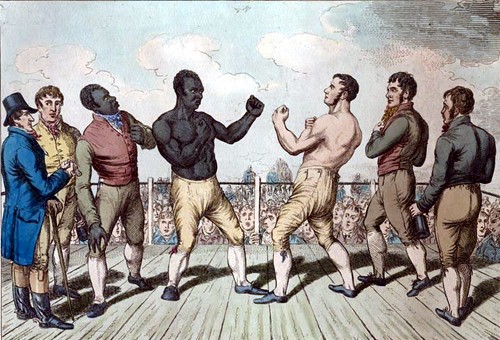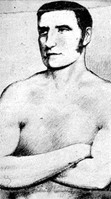|
Prize fighting WITH JOHN GUTTRIDGE OF BOURNE
Prize fighting dates from the early 18th century, the first known use of the phrase being in 1706, a sporting event between two professional boxers or fighters for a cash prize known as a purse [of money]. These fights were with bare knuckles although there was an accepted set of rules, such as not striking an opponent when he was down, but some bouts often lasted several hours and contestants were seriously hurt while deaths were not uncommon and some backers even prosecuted for manslaughter. Because of its brutality, prize fighting was an illegal and clandestine profession and bouts were held at secret locations yet still commanded large crowds of spectators. Many prize fighters had national reputations such as Tom Cribb, Jem Mace, Ben Caunt and William "Bendigo" Thompson, but all needed opponents and so most towns and villages sported a contender, always known by their surname and the name of where they came from and in Bourne during the early 19th century the local hopeful was John Guttridge. Although he never achieved the same fame, Guttridge of Bourne enjoyed a popular reputation locally and was always ready to fight a bout once the purse had been put up, usually by wealthy landowners and businessmen who enjoyed the sport. Bendigo, for instance, visited Bourne in the spring of 1845 to meet Guttridge although they were never matched professionally. Bendigo came after hearing of Guttridge's victory over Tansley, of Crowland, in a bout at Tongue End, near Bourne, which was fought on Wednesday 29th January 1845 for a purse of £10. Although the time and place of the contest had been kept secret, over 1,000 people turned up to what turned out to be a hard fought battle over 50 rounds which took 57 minutes, Guttridge was declared the winner and as a result was matched to fight Graham of Peterborough, better known as Potter George, later in the year. A purse of £50 [about £5,000 at today's value] was agreed and the date fixed for Wednesday 16th April at a place called Moonshine Gap, four miles from Gidding in Huntingdonshire, but the authorities got to hear of the arrangements and so the bout was switched to Wansford. Guttridge arrived at 12 noon as arranged but Graham did not make an appearance until 6.30 pm and without the ropes and stakes for the ring which his backers had agreed to provide. “The want of these requisites together with the lateness of the hour rendered it necessary to postpone the fight”, reported the Stamford Mercury. “The friends of Guttridge considered their man entitled to the stakes [wagers] but the editor of a sporting newspaper, on being made acquainted with the whole of the circumstances said that the breach of articles was not sufficiently apparent and another day for the fight had to be agreed upon.” A meeting was therefore held at the New Inn, Bourne, to determine the new date which was set for Wednesday 30th April and the venue selected was on the banks of the River Welland, a mile from Crowland, and the encounter was duly reported by the Stamford Mercury: Graham was attended by Dencock and Sharpe, his trainers, and Guttridge by Tansley and Phillips. Soon after nine o’clock, Graham threw his hat into the ring which was responded by Guttridge. The latter is considered a fine young man, 22 years of age, 5 feet 11 inches high and weighs 12 stones. Graham is between 30 and 40 years of age, 5 feet 10 inches high and weighs 11 stones 10 lb. The usual forms having been gone through, the fight began. ROUND 1: Both men eyed each other with great caution and at last Guttridge caught Graham on the throat: after some hard fighting, Guttridge was sent to the ground and the betting became 2 to 1 on Graham. ROUND 2: Guttridge jabbed with his left at the head but Graham caught him in return over his left eye and the former fell. ROUND 3: Guttridge hit out with his left at the head and his right went well home to the mouth. He, however, received a severe blow on the head and again went down. ROUND 4: Guttridge led off with his left and Graham came in but caught a tremendous blow over his left jaw which sent him to the earth. ROUND 5: Graham came up with his jaw much swollen; both seemed bent on mischief and some hard blows were exchanged, both eventually falling. ROUND 6: Only two blows were exchanged and both fell. The blood was then seen to flow from Guttridge’s nose and from Graham’s mouth. ROUND 7: From this round to the 22nd, Guttridge had one hand continually in Graham’s face and the other to his body which left Graham very little hope of victory although several times he had the better of the falls. ROUND 23: Graham caught Guttridge over his right arm and at the same time the latter hit his antagonist lightly and slipped down. Graham’s seconds here exclaimed “foul” and their man left the ring without saying a word. The umpires were appealed to, both of whom said “fair” and the referee ordered the fight to go on. Time having been called, Guttridge was ready but Graham was out of the ring and refused to fight again. Graham was sent for but he declared that he would not fight and the umpires and referee decided in favour of Guttridge. The fight had lasted for 20 minutes and even if the dispute had not arisen, it was the general opinion that it would not have continued for more than ten minutes longer. Many of Graham’s partisans were of the opinion that his conduct whilst training was not of that character to ensure a victory. Soon after the encounter with Graham at Crowland, Guttridge was badly injured although we have no information about the circumstances of the accident or how serious it was other than a report in the Stamford Mercury on Friday 16th January 1846 which said: "Guttridge has since had his knob broken and has fallen a charge to his parish", meaning that he could not pay for his treatment and had sought help from the Union. However, the newspaper report added: "His medical friend certifies that he is unable to be removed to the Union House. Where are those gentlemen, his backers and supporters? Echo only answers 'Where?'" Despite this setback, Guttridge went on to fight the celebrated middleweight champion Nat Langham at Bourne on 23rd September 1846, for a purse of £50, a bruising contest that went on for eighty-five rounds over a period of ninety-three minutes but he eventually suffered a defeat. In the first ten rounds, Langham had the advantage. For the next 40, Guttridge appeared to improve and from the 51st until the 93rd, Langham took control until Guttridge finally conceded. Eye witnesses of the encounter said later that after the third round, Guttridge struck the champion a tremendous blow in the throat, rendering him insensible. He might have claimed the fight and consequently the championship but he was “bustled out of it by Langham’s backers”. A return match was arranged for the following year, 2nd February 1847, at a venue halfway between London and Bourne and with a purse of £50, but there is no record of it ever having taken place. Guttridge may have continued fighting for a while but although the newspapers reported some bouts they were not enthusiastic about giving them coverage and were always critical and often condemnatory and so we do not have a complete record of his progress. There was an exception with The Era, a British weekly paper that appeared between 1838 to 1939 and became noted for its sports coverage, particularly prize fighting which was featured in a regular column entitled “The Ring”. Dates of forthcoming fights were published in each issue and even challenges between contestants together with details of the purse required and possible venues. From this we know that Guttridge was still trying to arrange bouts in the summer of 1847 but it is not known whether any firm dates materialised. Some prize fighters such as Jem Mace, for instance, remained in the profession for many years but his less distinguished colleagues did not share this good fortune and despite his early successes, John Guttridge does not appear to have had a long career in the ring and died at King’s Cliffe, Northamptonshire, in July 1893, aged 70, without achieving lasting fame. Bare knuckle fighting continued until the late 19th century, eventually becoming respectable and governed by strict rules to form the basis of the sport we know today as boxing.
Go to: Main Index Villages Index |

